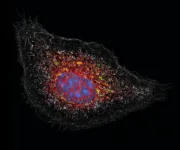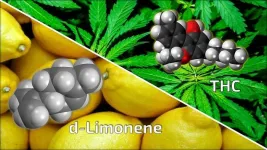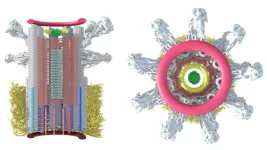(Press-News.org) Joint press release of Charité and Uniklinikum Erlangen
Cortisone and other related glucocorticoids are extremely effective at curbing excessive immune reactions. But previously, astonishingly little was known about how they exactly do that. A team of researchers from Charité – Universitätsmedizin Berlin, Uniklinikum Erlangen and Ulm University have now explored the molecular mechanism of action in greater detail. As the researchers report in the journal Nature,* glucocorticoids reprogram the metabolism of immune cells, activating the body’s natural “brakes” on inflammation. These findings lay the groundwork for development of anti-inflammatory agents with fewer and less severe side effects.
The glucocorticoid cortisone is actually naturally present in the body as cortisol, a stress hormone. The organism releases cortisol to improve the body’s responses to stress. Cortisol intervenes in sugar and fat metabolism and affects other parameters, including blood pressure and respiratory and heart rate. At higher doses, it also inhibits the activity of the immune system, which makes it useful for medical purposes: Due to their excellent efficacy, synthetic glucocorticoid derivates that inhibit inflammation, even more than the natural substance present in the body, are used to treat a wide range of immune-mediated inflammatory diseases. They are among the most widely used medications of all.
Glucocorticoids affect not only genes, but also cellular energy sources
However, glucocorticoid-based medications also have side effects, especially at higher doses and when administered for longer periods. These side effects are related to the other effects of the body’s own cortisol. They include high blood pressure, osteoporosis, diabetes, and weight gain. With the aim of developing anti-inflammatory agents with fewer and less severe side effects, a team of researchers led by Prof. Gerhard Krönke, director of the Department of Rheumatology and Clinical Immunology at Charité, has now conducted a closer study of how the immunosuppressive effects of glucocorticoids exactly works.
“It was previously known that glucocorticoids activate a number of genes in different cells of the body,” Krönke explains. “But through this mechanism, they mainly activate the resources present in the body. This does not adequately explains its strong immunosuppressive effect. In our study, we have now been able to show that glucocorticoids affect more than just the gene expression in immune cells. It also affects the cell´s powerhouses, the mitochondria. And that this effect on cell metabolism is in turn crucial to the anti-inflammatory effects exerted by glucocorticoids.”
Swords to plowshares
For the study, the research team focused on macrophages, a type of immune cell responsible for eliminating intruders such as viruses and bacteria. These cells can also play a role in the emergence of immune-mediated inflammatory diseases. The researchers studied how these immune cells – derived in this case from mice – responded to inflammatory stimuli in a laboratory setting and what effects additional administration of a glucocorticoid had. The researchers observed that in addition to its effect on gene expression, glucocorticoids had a major effect in reversing changes in the cell metabolism that had been initiated by the inflammatory stimuli.
“When macrophages are put into ‘fight’ mode, they redirect their cellular energy into arming for a fight. Instead of supplying energy, their mitochondria produce the components needed to fight intruders,” Krönke says, describing the processes involved. “Glucocorticoids reverse the process, switching the ‘fight’ mode back off and turning swords into plowshares, so to speak. A tiny molecule called itaconate plays an especially important role in this.”
Itaconate mediates anti-inflammatory effect of glucocorticoids
Itaconate is an anti-inflammatory substance that the body naturally produces inside its mitochondria. Macrophages produce it early on when they are activated so that the inflammatory reaction will subside after a certain period. Generation of this natural immune “brake”, however, requires sufficient fuel. When the cell´s powerhouses are arming up for a fight, that is no longer the case, so itaconate production dwindles to a halt after a while. With normal, short-term inflammation, this timing is effective because the immune response has also subsided in the meantime.
“With a persistent inflammatory stimulus, the drop-off in itaconate production is an issue because there is then no immune ‘brake’ even though the immune system is still running on all cylinders, eventually contributing to chronic inflammation,” explains Dr. Jean-Philippe Auger, a scientist at the Department of Medicine 3 – Rheumatology and Immunology at Uniklinikum Erlangen and the first author of the study. “This is where glucocorticoids intervenes. By reprogramming the mitochondrial function, they ramp up the formation of itaconate in the macrophages, restoring its anti-inflammatory effect.”
The search for new active substances
Using animal models for asthma and rheumatoid arthritis, the researchers were able to demonstrate how much the anti-inflammatory effect of glucocorticoids depends on itaconate. Glucocorticoids had no effect in animals that were unable to produce itaconate. So, if itaconate mediates the immunosuppressant effect of cortisone, wouldn’t it be possible to administer itaconate directly, instead of glucocorticoids?
“Unfortunately, itaconate isn’t a particularly good candidate as an anti-inflammatory drug, because it’s unstable, and due to its high reactivity, it could cause side effects if administered systemically,” Krönke explains. “Aside from that, we assume the processes in humans to be a bit more complex than those in mice. So our plan is to look for new synthetic compounds that are just as effective as glucocorticoids at reprogramming the mitochondrial metabolism inside immune cells, but have fewer and less severe side effects.”
*Auger JP et al. Metabolic rewiring promotes anti-inflammatory effects of glucocorticoids. Nature 2024 April 10, doi 10.1038/s41586-024-07282-7
About the study
The study was led by Prof. Gerhard Krönke, who initiated the work at the Department of Medicine 3 – Rheumatology and Immunology at Uniklinikum Erlangen, the medical center affiliated with Friedrich-Alexander-Universität Erlangen-Nürnberg (FAU), before moving to Charité. The first author of the publication, Dr. Jean-Philippe Auger, still works there. Jan Tuckermann, Professor at Ulm University and Dr. Eicke Latz, Professor of Experimental Rheumatology at Charité and Scientific Director of the German Rheumatism Research Centre Berlin (DRFZ), a Leibniz Institute, also contributed to the study. Krönke and Latz are working together in Berlin to develop new anti-inflammatory drugs and advance personalization in the field of rheumatology.
Related Links:
Department of Rheumatology and Clinical Immunology
END
How the body switches out of “fight” mode
Study in Nature unlocks how cortisone inhibits inflammation
2024-04-10
ELSE PRESS RELEASES FROM THIS DATE:
Physicists discover a novel quantum state in an elemental solid
2024-04-10
Physicists have observed a novel quantum effect termed “hybrid topology” in a crystalline material. This finding opens up a new range of possibilities for the development of efficient materials and technologies for next-generation quantum science and engineering.
The finding, published in the April 10th issue of Nature, came when Princeton scientists discovered that an elemental solid crystal made of arsenic (As) atoms hosts a never-before-observed form of topological quantum behavior. They were able to explore and image this ...
Researchers show chemical found naturally in cannabis may reduce anxiety-inducing effects of THC
2024-04-10
FOR IMMEDIATE RELEASE
A Johns Hopkins Medicine-led research team has added to evidence that a chemical found naturally in cannabis (also known as marijuana) can — in the right amounts — lessen the anxiety-inducing effects of tetrahydrocannabinol (THC), the primary psychoactive sister chemical found in cannabis. The finding has the potential to advance the medicinal use of THC, and reduce the risks of its recreational use in some people.
The substance, called d-limonene, is one of the most abundant terpenes, or essential oils, in the cannabis plant, and has shown promise in rodent studies in reducing anxiety behaviors. However, there has ...
AI-powered ‘sonar’ on smartglasses tracks gaze, facial expressions
2024-04-10
ITHACA, N.Y. – Cornell University researchers have developed two technologies that track a person’s gaze and facial expressions through sonar-like sensing. The technology is small enough to fit on commercial smartglasses or virtual reality or augmented reality headsets, yet consumes significantly less power than similar tools using cameras.
Both use speakers and microphones mounted on an eyeglass frame to bounce inaudible soundwaves off the face and pick up reflected signals caused by face and eye movements. ...
Newly found genetic variant defends against Alzheimer’s disease
2024-04-10
NEW YORK, NY (April 10, 2024)--Columbia researchers have discovered a genetic variant that reduces the odds of developing Alzheimer’s disease by up to 70% and may be protecting thousands of people in the United States from the disease.
The discovery of the protective variant, which appears to allow toxic forms of amyloid out of the brain and through the blood-brain barrier, supports emerging evidence that the brain’s blood vessels play a large role in Alzheimer's disease and could herald a new direction in therapeutic development.
“Alzheimer’s disease may get started with amyloid deposits in the brain, but ...
Serious flu damage prevented by compound that blocks unnecessary cell death
2024-04-10
As lung cells are killed by the influenza virus, they burst open, releasing molecular signals that trigger the immune cells that can combat the infection. This strategy can be an important red flag that something is wrong; however, if one cell death response, called necroptosis, continues unchecked, it can cause life-threatening injury to lung tissue. In a study published April 10 in the journal Nature, Tufts University School of Medicine scientists and collaborators present a newly developed compound ...
CHOP, Stanford researchers identify protein that controls CAR T cell longevity
2024-04-10
Philadelphia, April 10, 2024 – CAR T cell therapy has revolutionized the way certain types of cancer are treated, and the longer those CAR T cells live in a patient’s body, the more effectively they respond to cancer. Now, in a new study, researchers at Children’s Hospital of Philadelphia (CHOP) and Stanford Medicine have found that a protein called FOXO1 improves the survival and function of CAR T cells, which may lead to more effective CAR T cell therapies and could potentially expand its use in difficult-to-treat cancers. The findings were published online today by the journal Nature.
T ...
Race, ethnicity, and delayed time to COVID-19 testing among health care workers
2024-04-10
About The Study: In this cross-sectional study of health care personnel (HCP), compared with non-Hispanic white HCP and clinical HCP with graduate degrees, non-Hispanic Black HCP, non-Hispanic HCP of other races, and HCP of all other professional and education backgrounds were more likely to have delayed COVID-19 testing. These findings suggest that time to testing may serve as a valuable metric in evaluating sociodemographic disparities in the response to COVID-19 and future health mitigation strategies.
Authors: DaMarcus ...
Trends in deaths of despair by race and ethnicity
2024-04-10
About The Study: As of 2022, the midlife mortality rates from deaths of despair (deaths from suicide, drug overdose, and alcoholic liver disease) among Black individuals were higher than rates among white individuals, and rates among American Indian or Alaska Native individuals remained higher than rates in the other groups. Rising inequalities in deaths of despair among American Indian or Alaska Native and Black individuals were largely attributable to disproportionate early mortality from drug- and alcohol-related causes, which increased leading up to and during the COVID-19 pandemic.
Authors: Joseph ...
Revolutionary molecular device unleashes potential for targeted drug delivery and self-healing materials
2024-04-10
In a new breakthrough that could revolutionise medical and material engineering, scientists have developed a first-of-its-kind molecular device that controls the release of multiple small molecules using force.
The researchers from The University of Manchester describe a force-controlled release system that harnesses natural forces to trigger targeted release of molecules, which could significantly advance medical treatment and smart materials.
The discovery, published today in the journal Nature, uses a novel technique using a type of interlocked molecule known as rotaxane. Under the influence of mechanical force - such ...
The genesis of our cellular skeleton, image by image
2024-04-10
Cells contain various specialised structures - such as the nucleus, mitochondria or peroxisomes - known as “organelles’’. Tracing their genesis and determining their structure is fundamental to understanding cell function and the pathologies linked to their dysfunction. Scientists at the University of Geneva (UNIGE) have combined high resolution microscopy and kinematic reconstruction techniques to visualise, in motion, the genesis of the human centriole. This organelle, essential to the organisation of the cell skeleton, is associated - in case of dysfunction - with certain cancers, brain disorders or retinal diseases. This work, published in the journal Cell, elucidates ...
LAST 30 PRESS RELEASES:
Sport in middle childhood can breed respect for authority in adolescence
From novel therapies to first-in-human trials, City of Hope advances blood cancer care at the American Society of Hematology (ASH) annual conference
Research aims to strengthen the security of in-person voting machines
New study exposes hidden Alzheimer’s 'hot spots' in rural Maryland and what they reveal about America’s growing healthcare divide
ASH 2025: Study connects Agent Orange exposure to earlier and more severe cases of myelodysplastic syndrome
ASH 2025: New data highlights promise of pivekimab sunirine in two aggressive blood cancers
IADR elects George Belibasakis as vice-president
Expanding the search for quantum-ready 2D materials
White paper on leadership opportunities for AI to increase employee value released by University of Phoenix College of Doctoral Studies
ASH 2025: New combination approach aims to make CAR T more durable in lymphoma
‘Ready-made’ T-cell gene therapy tackles ‘incurable’ T-cell leukemia
How brain activity changes throughout the day
Australian scientists reveal new genetic risk for severe macular degeneration
GLP-1 receptor agonists likely have little or no effect on obesity-related cancer risk
Precision immunotherapy to improve sepsis outcomes
Insilico Medicine unveils winter edition of Pharma.AI, accelerating the path to pharmaceutical superintelligence
Study finds most people trust doctors more than AI but see its potential for cancer diagnosis
School reopening during COVID-19 pandemic associated with improvement in children’s mental health
Research alert: Old molecules show promise for fighting resistant strains of COVID-19 virus
Journal of Nuclear Medicine Technology supplement highlights advances in theranostics and opportunities for growth
New paper rocks earthquake science with a clever computational trick
ASH 2025: Milder chemo works for rare, aggressive lymphoma
Olfaction written in bones: New insights into the evolution of the sense of smell in mammals
Engineering simulations rewrite the timeline of the evolution of hearing in mammals
New research links health impacts related to 'forever chemicals' to billions in economic losses
Unified EEG imaging improves mapping for epilepsy surgery
$80 million in donations propels UCI MIND toward world-class center focused on dementia
Illinois research uncovers harvest and nutrient strategies to boost bioenergy profits
How did Bronze Age plague spread? A sheep might solve the mystery
Mental health professionals urged to do their own evaluations of AI-based tools
[Press-News.org] How the body switches out of “fight” modeStudy in Nature unlocks how cortisone inhibits inflammation







